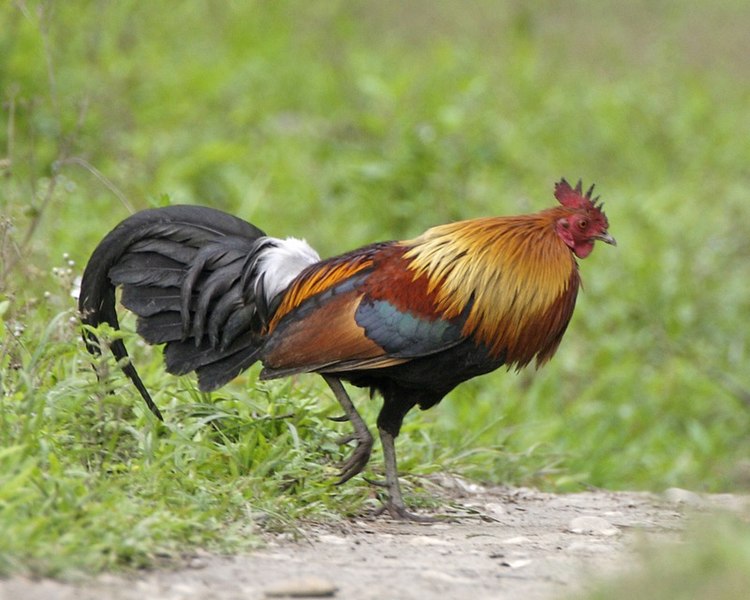Hello ladies and gents this is the Viking telling you that today we are talking about
CHICKEN
Galliformes, the order of bird that chickens belong to, is directly linked to the survival of birds when all other dinosaurs went extinct. Water or ground-dwelling fowl, similar to modern partridges, survived the Cretaceous–Paleogene extinction event that killed all tree-dwelling birds and dinosaurs. Some of these evolved into the modern galliformes, of which domesticated chickens are a main model. They are descended primarily from the red junglefowl (Gallus gallus) and are scientifically classified as the same species. As such, they can and do freely interbreed with populations of red junglefowl.
Subsequent hybridization of domestic chicken with grey junglefowl, Sri Lankan junglefowl and green junglefowl occurred with at least, a gene for yellow skin was incorporated into domestic birds through hybridization with the grey junglefowl (G. sonneratii). In a study published in 2020, it was found that chickens shared between 71% - 79% of their genome with red junglefowl with domestication period dated to 8,000 years ago.
The traditional view is that chickens were first domesticated for cockfighting in Asia, Africa, and Europe. In the last decade, there have been a number of genetic studies to clarify the origins. According to one early study, a single domestication event which took place in what now is the country of Thailand gave rise to the modern chicken with minor transitions separating the modern breeds. However, that study was later found to be based on incomplete data, and recent studies point to multiple maternal origins, with the clade found in the Americas, Europe, Middle East, and Africa, originating from the Indian subcontinent, where a large number of unique haplotypes occur.
The red junglefowl, known as the bamboo fowl in many Southeast Asian languages, is a special bird well-adapted to take advantage of the large amounts of fruits that are produced during the end of the 50-year bamboo seeding cycle, to boost its own reproduction. In domesticating the chicken, humans took advantage of this predisposition for prolific reproduction of the red junglefowl when exposed to large amounts of food.
Several controversies still surround the time chicken was domesticated. A recent molecular evidence obtained from whole-genome study published in 2020 reveal that chicken was domesticated 8,000 years ago.
Though, it was previously thought to have been domesticated in Southern China in 6000 BC based on paleoclimatic assumptions which has now raised doubts from another study that question whether those birds were the ancestors of chickens today. Majority of the world chicken today may have migrated from the Harappan culture of the Indus Valley. Eventually, the chicken moved to the Tarim basin of central Asia. The chicken reached Europe (Romania, Turkey, Greece, Ukraine) about 3000 BC.
Introduction into Western Europe came far later, about the 1st millennium BC. Phoenicians spread chickens along the Mediterranean coasts as far as Iberia. Breeding increased under the Roman Empire, and was reduced in the Middle Ages. Genetic sequencing of chicken bones from archaeological sites in Europe revealed that in the High Middle Ages chickens became less aggressive and began to lay eggs earlier in the breeding season.
Middle East traces of chicken go back to a little earlier than 2000 BC, in Syria; chickens went southward only in the 1st millennium BC. They reached Egypt for purposes of cockfighting about 1400 BC, and became widely bred only in Ptolemaic Egypt (about 300 BC). Little is known about the chicken's introduction into Africa. It was during the Hellenistic period (4th-2nd centuries BC), in the Southern Levant, that chickens began widely to be domesticated for food. This change occurred at least 100 years before domestication of chickens spread to Europe.
Three possible routes of introduction in about the early first millennium AD could have been through the Egyptian Nile Valley, the East Africa Roman-Greek or Indian trade, or from Carthage and the Berbers, across the Sahara. The earliest known remains are from Mali, Nubia, East Coast, and South Africa and date back to the middle of the first millennium AD.
Domestic chicken in the Americas before Western contact is still an ongoing discussion, but blue-egged chickens, found only in the Americas and Asia, suggest an Asian origin for early American chickens.
A lack of data from Thailand, Russia, the Indian subcontinent, Southeast Asia and Sub-Saharan Africa makes it difficult to lay out a clear map of the spread of chickens in these areas; better description and genetic analysis of local breeds threatened by extinction may also help with research into this area.

Comments
Post a Comment